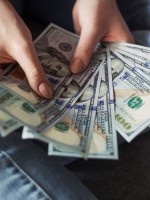World's 10 weakest currencies
No one wants to live in a country with a weak currency. It's not only frustrating for the citizens of that country, but it also creates problems for people outside of the nation. A weak currency means costs are higher and goods are more expensive, which is never good if you're trying to make money! That's why we've compiled this list of the 10 weakest currencies from around the world.
1.Venezuela Bolivar
Currency Code: VES (old VEF)
The Venezuelan bolivar is the weakest currency in the world. It's so weak that many of its citizens have been buying Bitcoin to protect themselves from inflation. One US dollar will buy you about one hundred thousand bolivars, and a Euro will get you around 55000 Bolivars. The problem with this country is its lack of product diversity (resulting in high prices) and because it has been under an economic crisis for years now.
Venezuela successfully redenominated its currency in August 2018. The most common reason for their weakness is hyperinflation. Before the redenomination, inflation was around 18,000% a year.
The bolivar is so devalued that the largest banknote—100,000 bolivars—is worth less than one cent of a US dollar or penny as of December 2018. The Venezuelan bolivar has been extremely weak for years now, and it's not looking like it will be getting any better soon.
Bitcoin acquisitions in Venezuela have spiked to record levels over the last few months, with cryptocurrency traders bypassing government strictures on foreign exchange markets by using Bitcoin instead. Inflation in Venezuela hit nearly 20 million percent annually last September when prices doubled every 17 days, according to Bloomberg data; more recently, inflation reportedly reached 40 million percent a month.
1 USD = 1,552,540 VES
1 EUR = 1,878,793 VES
2. Iranian Rial
Currency code – IRR.
The Iranian currency is also the weakest one in the world. The sanctions have been hurting this country for years, and so has their government's decision to make it harder to buy foreign goods.
This weakness could be attributed to high unemployment rates and trade embargoes from other countries that are not willing to do business with them because of international politics.
Iran successfully reinstated its old currency called Rial on March 21st, 2018, when inflation had reached an all-time high: 40% per day! Even though they restored their currency to where it previously stood before USA pulled out in 1979, it's been a long time since the Iranian people have not seen stability in their currency. When you need to convert different currencies every time, a tool currency converter at LowestCurrency.com can be helpful. It is too easy to use and can get results instantly.
1 USD = 41,908 IRR
1 EUR = 50,718 IRR
3. Vietnamese Dong
Currency code – VND.
One of the world's weakest currencies in Vietnam. The country still operates on a centralized economy, and as such, will likely continue to have devalued currency. The Dong has recently been amongst the "poorest currencies". Recent economic developments and internal policies have led to a steady devaluation where it now stands out as one of the world's poorest currencies.
Some say that the Vietnamese government is going in a good direction, and its currency will soon catch up to its neighbors.
Vietnamese Dong rates:
1 USD = 23,002 VND.
1 EUR = 27,860 VND.
4.Indonesian Rupiah
Currency code – IDR.
The Indonesian Rupiah is the world's ninth weakest currency. It has been amongst the "poorest currencies" for over a decade, and it doesn't look like things are getting better any time soon. The rupiah, which was pegged at IDR 14000 to USD in 1997, now stands at IDR 14,032 to USD, losing about 20% of its value since 2001. Furthermore, many people have started using US dollars as their everyday currency because they feel that it will be more stable in terms of purchasing power than the Indonesian Rupiah.
There are some signs, however, that Indonesia could turn around its lagging economy and weak currency by following China's lead into an expansive urbanization program:
Improving urban infrastructure
Building roads and bridges to rural areas
Expanding public housing programs in large urban cities
1 USD = 14,032 IDR
1 EUR = 16,978 IDR
5. Uzbek Sum
Currency code – UZS.
Amidst a period of economic downturn, the Uzbekistan Sum was reintroduced to replace inflation-ravaged currencies to ensure stability.
The effects of liberalizing monetary policy in September were astounding. The exchange rate of the Sum against the US dollar has been set at 1 USD to 8,100 UZS, where the true value of 1 US dollar was somewhere in the range of 8,000-8,150 UZS.
1 USD = 10,483 UZS
1 EUR = 12,687 UZS
6. Guinean Franc
Currency code – GNF.
As of November 2016, the Guinean Franc is one of the world's weakest currencies. The exchange rate for this currency is set at 111 GNF to US$ or 0.01 USD per GNF, and Euro rates are 135 EUR to GNF (or €0.00986) and 44.84 EUR to $USD ($0). The Guinea Franc was introduced in 1947 following French withdrawal from colonial holdings, including French Guinea, when it replaced both West African CFA francs and Malagasy ariary as legal tender before changing its name back after independence on October 24th, 1958. According to World Bank data, it has been unstable ever since, with inflation hitting up 86% last year. High levels of corruption have also plagued the country's economy, with Transparency International ranking Guinea as 150 out of 176 in its 2016 Corruption Perception Index.
The currency has also been hurt by a lack of foreign exchange liquidity, with one major bank holding all available reserves. With no access to external financing and few natural resources, prospects for economic development are bleak. There is little hope that this Franc will improve anytime soon without significant reform efforts.
1 USD = 10,234 GNF.
1 EUR = 12,384 GNF.
7. Sierra Leonean Leone
Currency code – SLL.
The Sierra Leonean leone is the currency of Sierra Leone. It was introduced on 18 April 2000 to replace the Sierra Leone dollar at par, following that country's civil war and hyperinflation in 1999. The word "leone" means lion or a large cat in some languages and an Italian term for "lion".
Purpose: To be used throughout the Republic of Liberia (formerly known as Lib- eria) by people who make regular transactions such as buying groceries in shops or filling up their cars with gasoline. It also provides backup money if something happens to US dollars because there has been controversy surrounding them recently due to Trump's victory and whether he will cause any major changes to the US economy.
1 USD = 10,213 SLL
1 EUR = 12,360 SLL
8. Lao or Laotian Kip
Currency code – LAK.
The Lao Kip was introduced as the current currency of Laos in 1956, replacing French Indo-China piastres. Vietnamese piastres, Cambodian riel, Chinese yuan, or Korean won for transactions and government accounts.
Purpose: a small number of people uses it but mostly rely on bartering with other currencies such as Thai Baht or US dollars. Most goods can be bought using these instead, albeit at an inflated cost that ends up being passed onto customers who have no choice but to buy from local businesses and traders because they cannot afford imported products that come through formal channels via Thailand Vietnam.
1 USD = 9,322 LAK
1 EUR = 11,281 LAK
9. Paraguayan Guarani
Currency code – PYG.
Paraguay has the second least powerful currency in South America. It is a country with an economically struggling past, and many of these weaknesses contribute to the weakness of its currency. The lack of strong exports coupled with a history of economic problems, such as corruption and inflation, have caused the Paraguayan guarani to be one of the "weakest" currencies in the world.
1 USD = 6,874 PYG
1 EUR = 8,322 PYG
10. Cambodian Riel
Currency code – KHR.
Cambodia's currency, the Cambodian Riel, is one of the weakest in Asia. The country has a relatively low GDP and an unstable economy. Currently, it imports more than 50% of all its goods from exports which makes up for 90% of their import revenue. This dependency on others leaves Cambodia vulnerable to economic and political changes happening around them, and as such, it can't provide stability or growth for its people.
The weakness of this currency also results from a high level of corruption within government institutions which affects business investors' decisions about investing in Cambodia - they are wary that their investments will be stolen by corrupt officials if left unprotected through legal channels. All these factors contribute to making this region's currencies among the weakest in the world.
1 USD = 4,055 KHR
1 EUR = 4,908 KHR
More to Read:
Previous Posts:





